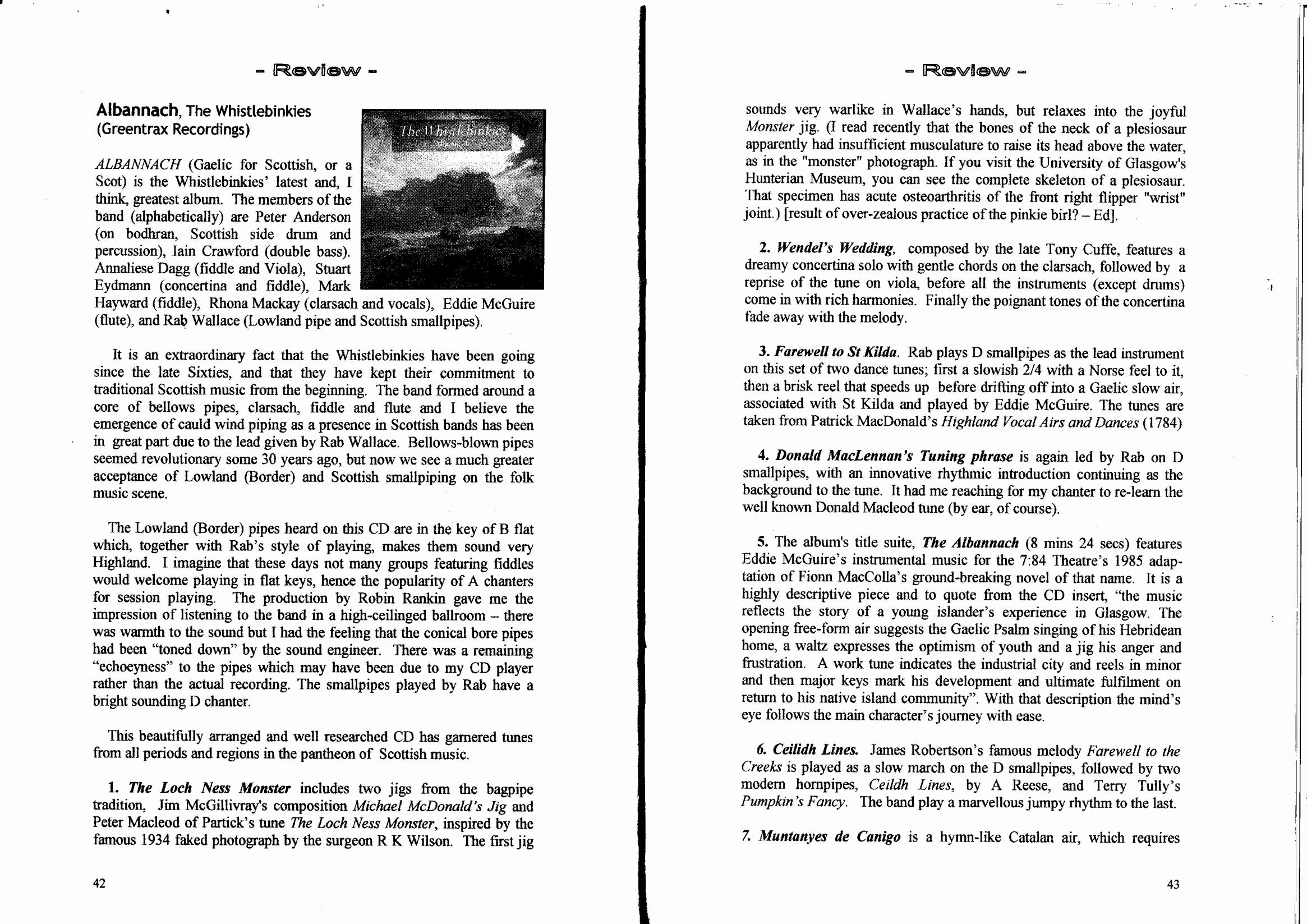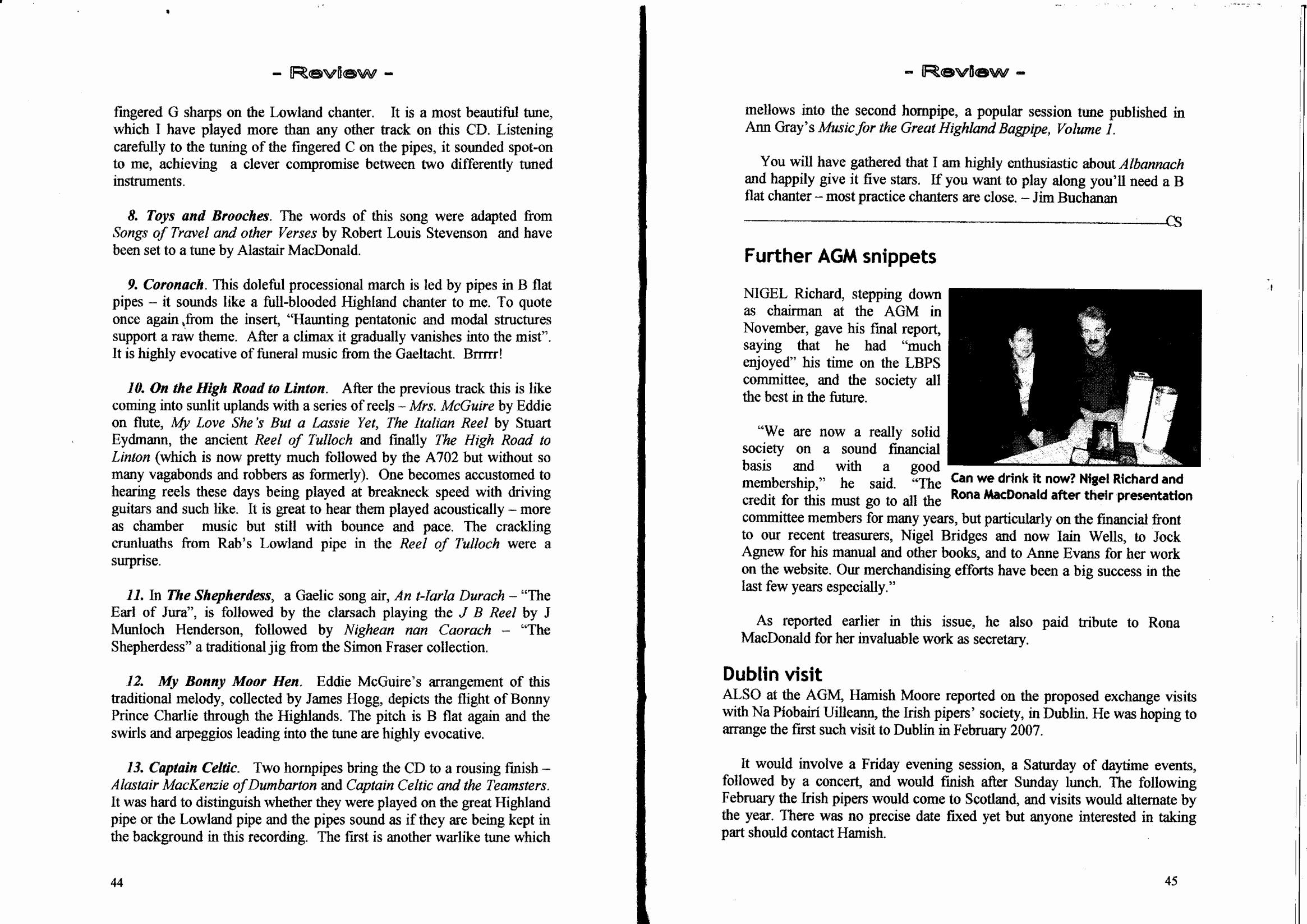Review CD Albannach


ALBANNACH (Gaelic for Scottish, or a Scot) is the Whistlebinkies’ latest and, I think, greatest album. The members of the band (alphabetically) are Peter Anderson (on bodhran, Scot- tish side drum and percus- sion), Iain Crawford (double bass), Annaliese Dagg (fiddle and Viola), Stuart Eydmann (concertina and fiddle), Mark Hayward (fiddle), Rhona Mackay (clarsach and vocals), Eddie McGuire (flute), and Rab Wallace (Lowland pipe and Scottish smallpipes).
It is an extraordinary fact that the Whistlebinkies have been going since the late Sixties, and that they have kept their
commitment to traditional Scottish music from the beginning. The band formed around a core of bellows pipes, clarsach, fiddle and flute and I believe the emergence of cauld wind piping as a presence in Scottish bands has been in great part due to the lead given by Rab Wallace. Bellows-blown pipes seemed revolutionary some 30 years ago, but now we see a much greater acceptance of Lowland (Border) and Scottish smallpiping on the folk music scene.
The Lowland (Border) pipes heard on this CD are in the key of B flat which, together with Rab’s style of playing, makes them sound very Highland. I imagine that these days not many groups featuring fiddles would welcome playing in flat keys, hence the popularity of A chanters for session playing. The production by Robin Rankin gave me the impression of listening to the band in a high-ceilinged ballroom - there was warmth to the sound but I had the feeling that the conical bore pipes had been “toned down” by the sound engineer. There was a remaining “echoeyness” to the pipes which may have been due to my CD player rather than the actual recording. The smallpipes played by Rab have a bright sounding D chanter.
This beautifully arranged and well researched CD has garnered tunes from all periods and
regions in the pantheon of Scottish music.
The Loch Ness Monster includes two jigs from the bagpipe tradition, Jim McGillivray’s composition Michael McDonald’s Jig and Peter Macleod of Partick’s tune The Loch Ness Monster, inspired by the famous 1934 faked photograph by the surgeon R K Wilson. The first jig sounds very warlike in Wallace’s hands, but relaxes into the joyful Monster jig. (I read recently that the bones of the neck of a plesiosaur apparently had insufficient muscula- ture to raise its head above the water, as in the “monster” photograph. If you visit the University of Glasgow’s Hunterian Museum, you can see the complete skeleton of a plesiosaur. That specimen has acute osteoarthritis of the front right flipper “wrist” joint.) [result of over-zealous practice of the pinkie birl? - Ed].
Wendel’s Wedding, composed by the late Tony Cuffe, features a dreamy concertina solo with gentle chords on the clarsach, followed by a reprise of the tune on viola, before all the instruments (except drums) come in with rich harmonies. Finally the poignant tones of the concertina fade away with the melody.
Farewell to St Kilda. Rab plays D smallpipes as the lead instrument on this set of two dance tunes; first a slowish 2/4 with a Norse feel to it, then a brisk reel that speeds up before drift- ing off into a Gaelic slow air, associated with St Kilda and played by Eddie McGuire. The tunes are taken from Patrick MacDonald’s Highland Vocal Airs and Dances (1784)
Donald MacLennan’s Tuning phrase is again led by Rab on D smallpipes, with an innova- tive rhythmic introduction continuing as the background to the tune. It had me reaching for my chanter to re-learn the well known Donald Macleod tune (by ear, of course).
The album’s title suite, The Albannach (8 mins 24 secs) features Eddie McGuire’s instru- mental music for the 7:84 Theatre’s 1985 adaptation of Fionn MacColla’s ground-breaking novel of that name. It is a highly descriptive piece and to quote from the CD insert, “the music reflects the story of a young islander’s experience in Glasgow. The opening free-form air suggests the Gaelic Psalm singing of his Hebridean home, a waltz expresses the opti- mism of youth and a jig his anger and frustration. A work tune indicates the industrial city and reels in minor and then major keys mark his development and ultimate fulfilment on return to his native island community”. With that description the mind’s eye follows the main character’s journey with ease.
Ceilidh Lines. James Robertson’s famous melody Farewell to the Creeks is played as a slow march on the D smallpipes, followed by two modern hornpipes, Ceilidh Lines, by A Reese, and Terry Tully’s Pumpkin’s Fancy. The band play a marvellous jumpy rhythm to the last.
Muntanyes de Canigo is a hymn-like Catalan air, which requires fingered G sharps on the Lowland chanter. It is a most beautiful tune, which I have played more than any other track on this CD. Listening carefully to the tuning of the fingered C on the pipes, it sounded spot- on to me, achieving a clever compromise between two differently tuned instruments.
Toys and Brooches. The words of this song were adapted from Songs of Travel and other Verses by Robert Louis Stevenson and have been set to a tune by Alastair MacDonald.
Coronach. This doleful processional march is led by pipes in B flat pipes - it sounds like a full-blooded Highland chanter to me. To quote once again from the insert, “Haunting penta- tonic and modal structures support a raw theme. After a climax it gradually vanishes into the mist”. It is highly evocative of funeral music from the Gaeltacht. Brrrrr!
On the High Road to Linton. After the previous track this is like coming into sunlit uplands with a series of reels - Mrs. McGuire by Eddie on flute, My Love She’s But a Lassie Yet, The Italian Reel by Stuart Eydmann, the ancient Reel of Tulloch and finally The High Road to Linton (which is now pretty much followed by the A702 but without so many vagabonds and robbers as formerly). One becomes accustomed to hearing reels these days being played at breakneck speed with driving guitars and such like. It is great to hear them played acous- tically - more as chamber music but still with bounce and pace. The crackling crunluaths from Rab’s Lowland pipe in the Reel of Tulloch were a surprise.
In The Shepherdess, a Gaelic song air, An t-Iarla Durach - “The Earl of Jura”, is followed by the clarsach playing the J B Reel by J Munloch Henderson, followed by Nighean nan Caorach - “The Shepherdess” a traditional jig from the Simon Fraser collection.
My Bonny Moor Hen. Eddie McGuire’s arrangement of this traditional melody, collected by James Hogg, depicts the flight of Bonny Prince Charlie through the Highlands. The pitch is B flat again and the swirls and arpeggios leading into the tune are highly evocative.
Captain Celtic. Two hornpipes bring the CD to a rousing finish - Alastair MacKenzie of Dumbarton and Captain Celtic and the Teamsters. It was hard to distinguish whether they were played on the great Highland pipe or the Lowland pipe and the pipes sound as if they are being kept in the background in this recording. The first is another warlike tune which mellows into the second hornpipe, a popular session tune published in Ann Gray’s Music for the Great Highland Bagpipe, Volume 1.
You will have gathered that I am highly enthusiastic about Albannach and happily give it five stars. If you want to play along you’ll need a B flat chanter - most practice chanters are close. - Jim Buchanan
